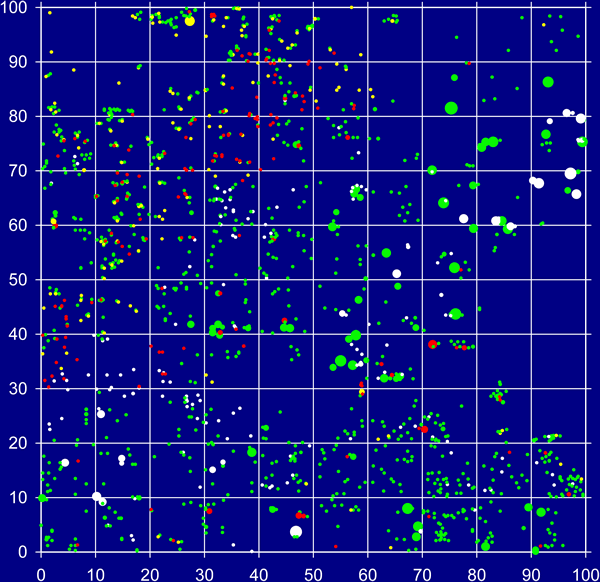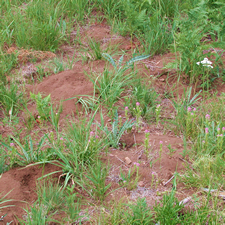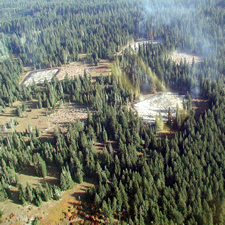| |
|
|
Mountain
meadows throughout the Pacific Northwest are undergoing rapid invasion
by conifers. At Bunchgrass Ridge we are exploring the history, potential
causes, and ecological consequences of these invasions, and testing
the potential to restore naive meadows through tree removal and
prescribed fire. Here we report the highlights and key findings
of our work.
Click on the thumbnails below to see details of relevant research.
|
|
 |
1.
Patterns of conifer invasion |
-
Changes
in climate and disturbance regimes. At
Bunchgrass Ridge, conifer establishment during the 20th
century was not correlated with variation in climate,
but may have been triggered by a change in disturbance
regime (grazing or fire).
-
Role
of biotic interactions. Spatial and temporal
patterns of recruitment of lodgepole pine and grand fir
suggest that once establishment is initiated, strong positive
interactions among trees can facilitate rapid conversion
of meadow to forest—even when climatic conditions
are not conducive to establishment.
-
Recommendation.
Removing trees early in the invasion process can preempt
these interactions and the ecological changes that accompany
conversion of meadow to forest.
|
|
_15%20Jul%202007_thmb.jpg) |
2.
Vegetation responses to tree encroachment |
-
Replacement
of meadow by forest species.
Conifer establishment results in rapid replacement of
meadow forbs and grasses by mesic forest herbs. Within
60-80 yr, understories may be dominated by forest species.
-
Tree species have differing
effects. Lodgepole pine and grand fir
differ markedly in their effects on the ground-layer community.
Under grand fir, cover and diversity of forest herbs rise
steeply with tree age (or size). Similar changes do not
occur under pine. Instead its effects on the ground vegetation
appear to be indirect, through its strong facilitation
of grand fir.
-
Meadow species are largely
absent from the soil seed bank. 75%
of the species present in these meadows are absent from
the soil seed bank. Seed banks are instead dominated by
weedy, ruderal species. As a consequence, there is limited
potential for seed banks to contribute to recovery of
meadow species lost to conifer encroachment.
-
Seed
dispersal and vegetative spread. Given
their absence from the seed bank, species’ reestablishment
during restoration hinges on natural seed dispersal or
gradual vegetative spread from adjacent meadow openings.
-
Recommendation.
Restoration will be most successful where it targets ecotonal
(edge) environments or tree islands to maximize the potential
for dispersal of meadow species.
|
 |
 |
3.
Role of gophers in meadow community structure |
-
Importance
of gopher disturbance. Gopher disturbances
(including mounds, tunnels, and castings) are common features
of Cascade meadows and contribute in important ways to
plant community structure.
Mounds bury plants, reset succession, reduce dominance
of competitively superior grasses and sedges, and increase
variability of species composition at local and larger
spatial scales. In
the absence of gophers, meadows that currently support
a diverse array of forbs and graminoids would become increasingly
dominated by grasses.
|
 |
 |
4.
Potential for meadow restoration with tree removal and fire |
-
Tree
removal over snow. Felling and yarding
over deep snow resulted in little disturbance to soils.
Climate warming and reductions in snow pack could pose
challenges to this approach in the future.
-
Operational
tradeoffs of fuel-reduction methods. Broadcast
and pile burning can be effective at reducing ground fuels,
but involve tradeoffs. Creating slash piles can be labor-intensive,
but piles can be burned in late fall or early winter when
fire risk and containment costs are low. Broadcast burning
does not require redistributing fuels, but weather conditions
are more restrictive and costs of containment can be high.
-
Effects
of burning on soils. In broadcast burned
plots, fire consumed the majority of fine fuels within
2 hr. Burning resulted in some exposure of mineral soil,
but most of the ground surface was covered by charred
litter or duff. Effects on soil chemistry were limited
to a transient (first-year) increase in available N.
In
pile-and-burn plots, slash piles burned to completion
within 2 days (95-100% consumption). Burn scars covered
<10% of the ground surface but only scar centers showed
signs of severe burning. Effects on soil chemistry included
small, but significant changes in soil carbon (loss) and
pH (increase), and a dramatic increase in available N.
N concentrations declined over time, but remained elevated
in year 3.
-
Gophers
reinvade meadows and dampen effects of burning.
Soil disturbance by gophers increased significantly over
time. Mixing of sub-surface and surface soils greatly
dampened the effects of broadcast and pile burning.
-
Vegetation
responses to tree removal. Short-term
responses to tree removal suggest strong potential to
reverse the effects of decades to well over a century
of tree influence. Tree removal, with or without fire,
benefited meadow species at the expense of forest herbs.
-
Necessity
of fire?
Fire does not appear critical to recovery of native meadow
communities in the short term. For most measures of vegetation
response, effects of burning were no different from those
of tree removal alone.
-
Ruderal
species.
Ruderal species were uncommon in the post-treatment vegetation,
despite their abundance in the soil seed bank. Exposure
or heating of mineral soil may not have been sufficient
to promote germination in burned plots, but heating beneath
burn piles probably destroyed most viable seeds.
-
Re-invasion
of conifers.
Conifer establishment was sparse and no greater in burned
than in unburned plots. Although of limited importance
in the short-term, abundant seed sources and germination
sites create the potential for future invasion.
-
Recovery
from a broad range of initial states.
Recovery of meadow species was clearly evident among the
full range of initial vegetation states (young to old
forest). However, restoration is far from complete and
hinges on the ability of species to disperse from adjacent
meadows and residual openings.
|
 |
| |
 |
 |
|
 |
|
|
 |
|
![]()
![]()
![]()
![]()


_15%20Jul%202007_thmb.jpg)

